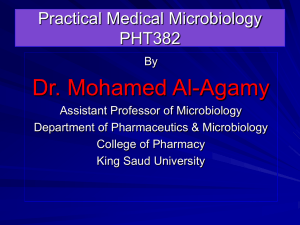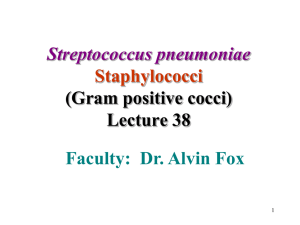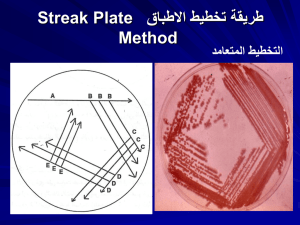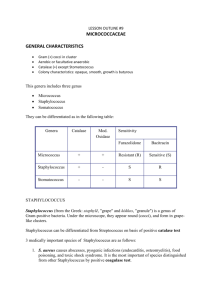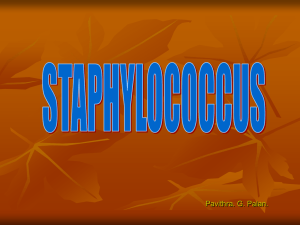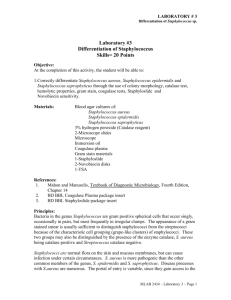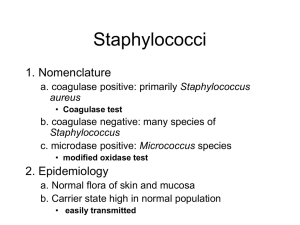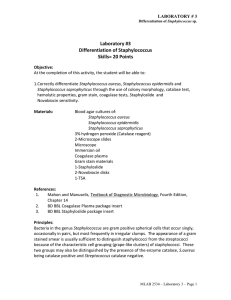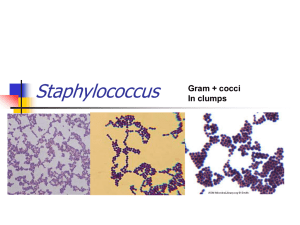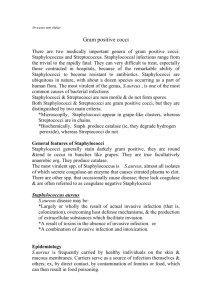Staphylococcus
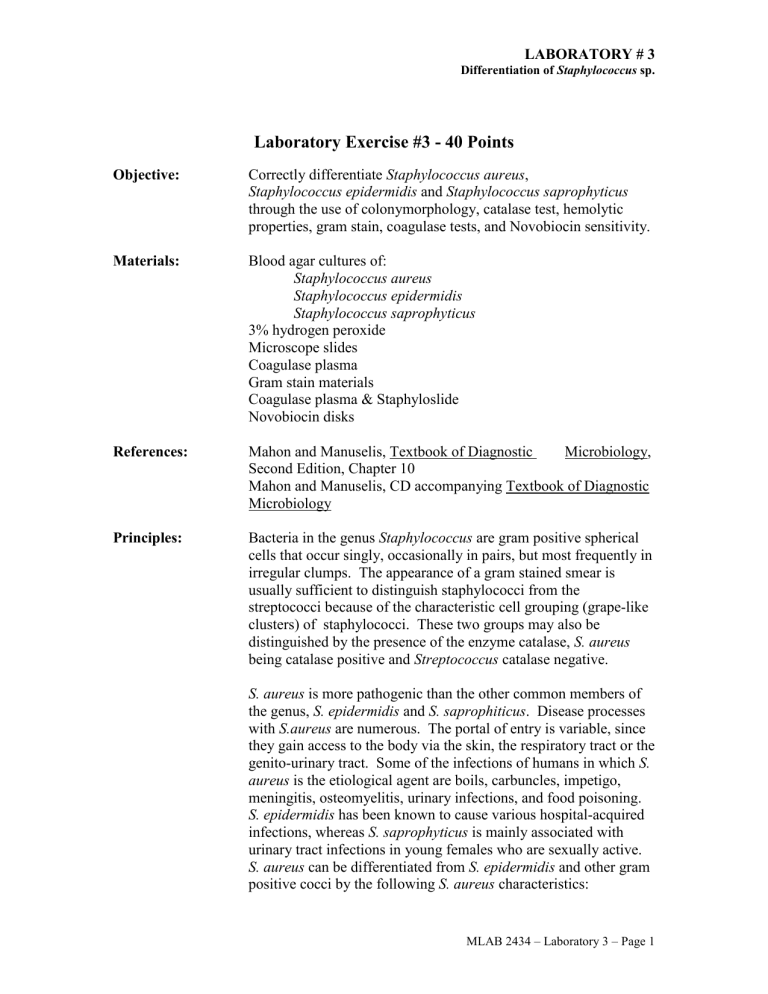
Objective:
Materials:
References:
Principles:
LABORATORY # 3
Differentiation of Staphylococcus sp.
Laboratory Exercise #3 - 40 Points
Correctly differentiate Staphylococcus aureus ,
Staphylococcus epidermidis and Staphylococcus saprophyticus through the use of colonymorphology, catalase test, hemolytic properties, gram stain, coagulase tests, and Novobiocin sensitivity.
Blood agar cultures of:
Staphylococcus aureus
Staphylococcus epidermidis
Staphylococcus saprophyticus
3% hydrogen peroxide
Microscope slides
Coagulase plasma
Gram stain materials
Coagulase plasma & Staphyloslide
Novobiocin disks
Mahon and Manuselis, Textbook of Diagnostic Microbiology,
Second Edition, Chapter 10
Mahon and Manuselis, CD accompanying Textbook of Diagnostic
Microbiology
Bacteria in the genus Staphylococcus are gram positive spherical cells that occur singly, occasionally in pairs, but most frequently in irregular clumps. The appearance of a gram stained smear is usually sufficient to distinguish staphylococci from the streptococci because of the characteristic cell grouping (grape-like clusters) of staphylococci. These two groups may also be distinguished by the presence of the enzyme catalase, S. aureus being catalase positive and Streptococcus catalase negative.
S. aureus is more pathogenic than the other common members of the genus, S. epidermidis and S. saprophiticus . Disease processes with S.aureus
are numerous. The portal of entry is variable, since they gain access to the body via the skin, the respiratory tract or the genito-urinary tract. Some of the infections of humans in which S. aureus is the etiological agent are boils, carbuncles, impetigo, meningitis, osteomyelitis, urinary infections, and food poisoning.
S. epidermidis has been known to cause various hospital-acquired infections, whereas S. saprophyticus is mainly associated with urinary tract infections in young females who are sexually active.
S. aureus can be differentiated from S. epidermidis and other gram positive cocci by the following S. aureus characteristics:
MLAB 2434 – Laboratory 3 – Page 1
LABORATORY # 3
Differentiation of Staphylococcus sp.
Test(s)
Pigment
Hemolysis
Catalase
Coagulase
Novobiocin
Mannitol
S. aureus
Gold-white
+
+
+
S
+
White-yellow
-
+
-
S
-
S. epidermidis
+
-
R
S. saprophyticus
White-yellow
-
-
S = Sensitive
R = Resistant
Procedure:
1.
Colony Morphology
Observe individual colonies of S. aureus , S. epidermidis and S.. saprophyticus .
Record the colony morphology and color of each on the chart at the end of this exercise.
2.
Catalase Test
Staphylococcus species contain the enzyme catalase, whereas most species of
Streptococcus (another gram positive coccus) do not. Catalase will break down hydrogen peroxide. When mixed with 3% hydrogen peroxide, catalase positive organisms will generate bubbles of oxygen which are visible to the naked eye.
Catalase negative organisms do not. It is preferable to test colonies from media without blood since erythrocytes possess catalase activities.
H
2
O
2
→ H
2
O + O
2
(gas bubbles) a.
Test S. aureus , S. epidermidis and S. saprophyticus for catalase activity. For each, use a clean slide. With a loop, transfer cells from the center of a wellisolated colony to the surface of the slide. b.
Add 1 or 2 drops of 3% hydrogen peroxide.
Interpretation: Rapid appearance and sustained production of gas bubbles or effervescence is indicative of a positive test. Since some bacteria may possess enzymes other than catalase that can decompose hydrogen peroxide, a few tiny bubbles forming after 20 to 30 seconds is not considered a positive test. Record results for each organism .
3.
Hemolytic Properties
Some bacteria synthesize the enzyme hemolysin . Hemolysin is an exoenzyme that lyses red blood cells. If a colony of bacterial cells is producing hemolysin and secreting it into the medium, there will be a round, clear zone surrounding the colony because the red blood cells in that area have been lysed (zone of hemolysis). S. aureus is usually hemolytic, but sometimes it is not. The presence or absence of hemolytic properties, therefore, cannot be used as a definitive identification of
MLAB 2434 – Laboratory 3 – Page 2
LABORATORY # 3
Differentiation of Staphylococcus sp.
Staphylococcus species. a.
Observe the blood agar plates of S. aureus, S. saprophyticus and S. epidermidis ; note any zone of hemolysis around well-isolated colonies. b.
Record your observations in the appropriate columns of the chart.
4 . Gram Stain
As previously mentioned, species of Staphylococcus and gram positive cocci may occur singly, occasionally in pairs, but most often in clusters. a.
Prepare smears of the three organisms as previously instructed. b.
Carefully gram stain each slide and allow to air dry or blot gently . c.
Under oil immersion, observe the gram reaction, morphology and arrangement of cells for each organism. d.
Record your observations.
5.
Coagulase Test
Coagulase is an exoenzyme that causes fibrin of blood plasma to clot. Pathogenic
S.aureus
produces coagulase, while non-pathogenic strains are coagulase negative.
Two forms of coagulase may be produced by S. aureus : free and/or bound .
The slide test is simple to perform and rapid, but detects bound coagulase only.
Therefore, all negative slide coagulase must be followed by a tube test, which will detect both bound and free coagulase. In this exercise perform a slide and tube coagulase test on both organisms, regardless of the results of the slide test. a.
Rapid Slide Test
1) For each organism, use a clean glass slide. Place one drop of coagulase plasma on each. Emulsify a loopful of the colonies to be tested in the drop on the appropriate slide.
2) Mix with the loop to obtain a smooth suspension. Gently rock the slide.
3) If the test is coagulase positive, visible clumps will appear within 1 to 2 minutes. It may be necessary to observe the mixture over a lamp to see the clumping appearance.
4) Discard slides in a container of disinfectant and record results for each organism. b.
Tube Test
1) For each organism, label a small test tube. Place approximately 0.5 ml of diluted plasma into each tube.
2) Inoculate the plasma with a large loopful of the colonies to be tested.
3)
Incubate the tubes in a 37°C incubator or waterbath. Coagulase positive organisms usually produce a visible clot within 1-4 hours.
If negative after this time, incubate 24-48 hours and observe again for clot formation.
4) Record results. Hold negative for the next session by parafilming the tubes and reincubating.
c.
Staphyloslide
Perform according to package instructions and record results.
MLAB 2434 – Laboratory 3 – Page 3
LABORATORY # 3
Differentiation of Staphylococcus sp.
6.
Novobiocin Susceptibility a.
Streak S. epidermidis and S. saprophyticus on a blood agar plate to obtain a good lawn of growth. b.
Place a 5 µg novobiocin disk in the center of the inoculum. c.
Incubate at 37°C for 18 to 24 hours. d.
Examine the plate for inhibition around the disk. Measure the zone diameter in millimeters and record results. e.
Susceptible zone: > 16 mm f.
Resistance: equal to or lesser than 16 mm.
S. saprophyticus is resistant; S. epidermidis is sensitive.
MLAB 2434 – Laboratory 3 – Page 4
LABORATORY # 3
Differentiation of Staphylococcus sp.
Staphylococcus Differentiation
Name ___________________________________ Date _______________________
S. aureus S. epidermidis S. saprophyticus Test
Colony Morphology
Catalase
Hemolytic
Properties
Gram Stain &
Morphology
Slide Coagulase
Tube Coagulase
Staphyloslide
Novobiocin
Sensitivity
MLAB 2434 – Laboratory 3 – Page 5

